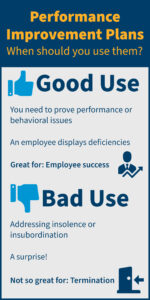You hire every employee to succeed in your organization. But sometimes you have an employee with a bad attitude or maybe an employee who hasn’t met a sales quota or a safety standard. Their performance needs to change, so is it time for a performance improvement plan (PIP)?
That’s all going to depend. Do you have an end game in mind already? Do you want the employee to work out and improve? Or is this about terminating or transferring an employee?
If your end game is terminating an employee, consider that your documentation for this employee should already exist, and a PIP isn’t your best option. If your goal is to help the employee improve on their performance, consider a coaching plan, or a performance improvement plan.
Performance improvement plans (PIPs) are effective in addressing performance issues versus behavior. A PIP’s goal is to help the employee progress. Giving an employee 90 days to improve their sales numbers makes sense, whereas giving someone 30 days to stop harassing their co-worker does not. Why else do we call them “improvement” plans?
Typically, before a PIP even begins, there is a record used to document a verbal warning or conversation (so you keep a copy but don’t give one to the employee). This record is usually reserved for a first offense. The second warning is usually a written one, signed by the employee.
If the employee still hasn’t fixed the issue, you can put a PIP in place for a pre-determined period (usually 60, 90, or 120 days). They involve regular meetings to evaluate the employee’s progress, require commitments from both the employee and supervisor and contain realistic, attainable goals.
Make sure you are clear as to what will happen should they fail to improve or modify their behavior at the end. If the employee doesn’t improve, you should close the PIP and determine the next course of action regarding the employee (e.g., transfer, demotion, termination) depending on the circumstance. If the employee is improving but falls short of the agreed-upon timeline, it’s okay to extend the plan. Or it may be that the plan’s goals were set too high and the employee has improved successfully, despite not meeting the high expectation.
The PIP’s downside is its bad reputation, so you may want to consider that when you decide how to talk to your employee about their PIP. Most workers see PIPs as part of the termination process, and they tend to be right, the result often is termination, transfer, or demotion. If you think this negative association may be too much, consider whether the employee could respond to effective coaching.
Coaching
There was a Forbes article this past July that encouraged the downplay of PIPs for the idea of “coaching improvement plans.” Although this seems like a formalized term for something that managers may already use informally, the concepts are like the PIP without the negative blowback.
Author Dr. Flo Falayi, asks us to consider some of the following ideas in place of a PIP:
- Communicate expectations. Describe in detail what the issues, opportunities, gaps and possibilities are.
- Create visual maps and tangible targets. Articulate how you would personally bridge the gap if you were the employee.
- Plan it. Create a clear SMART (specific, measurable, achievable, relevant, time-bound) plan for achieving the stated goal.
- Think broadly. Explore beyond the confines of the company and consider how you can equip your employee to succeed on another team or organization.
- Be human. Allow the employee to share their career plan, and collaborate on the path to success.
- Invite others. Ensure the road map includes observations and one-on-one sessions with other mentors and coaches.
- Schedule check-ins. Define your check-ins as learning events to discover, explore and brainstorm
Most of these ideas still require documentation. Although the goal of coaching is to build up an employee to be successful, if things aren’t working out, you’re already armed with documentation showing that you have worked with the employee to the best of your ability.
Returning to the employee with performance issues, regardless of whether you use a PIP or try to coach them, clearly communicate your expectations for their success.

